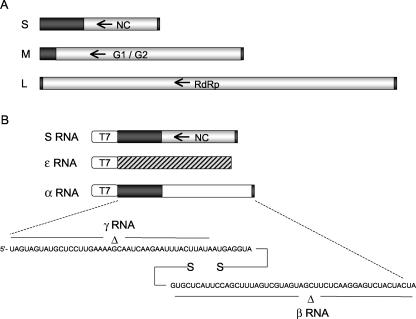FIG. 1.
Hantavirus RNAs. The three negative-sense viral RNAs are depicted in panel A. The S segment encodes the N protein (NC), the M segment encodes viral envelope proteins G1 and G2, and the L segment encodes the RNA-dependent RNA polymerase (RdRp). The coding regions are indicated, and the flanking noncoding regions are shown in black. Arrows indicate gene orientation. Synthetic RNAs derived by in vitro transcription are shown in panel B. DNA template construction is described in the text. S RNA is initiated via correct juxtaposition of a T7 promoter to the S-segment nucleic acid. Truncation of the template was achieved by cleavage with the type I restriction enzyme BsmBI. A BsmBI site was placed distal to the S-segment transcription unit such that cleavage would result in a 5′ template nucleotide in the template DNA strand that ends at a site corresponding to the 3′-terminal nucleotide of the viral RNA. As described in the text, ɛ RNA is a nonviral RNA synthesized with T7 polymerase (indicated by diagonal markings). α RNA contains foreign RNA in place of the NC gene (indicated in white). The terminal nucleotides present in both S RNA and α RNA are shown at the bottom of panel B. γ RNA contains a 42-nucleotide deletion at the 5′ end of the genome, and β RNA contains a 42-nucleotide deletion at the 3′ end of the genome, as indicated.

